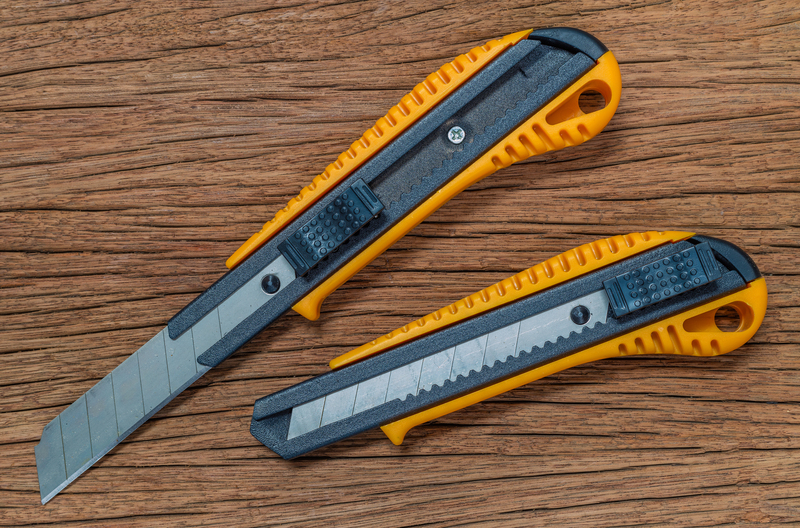Efficient Strategies for Lifting Heavy Objects by Yourself
Posted on 21/05/2025
Efficient Strategies for Lifting Heavy Objects by Yourself
If you've ever needed to move a heavy item by yourself--whether it's a piece of furniture, an appliance, building materials, or even boxes--the first thing you notice is how challenging and potentially risky it can be. Lifting weighty objects can cause back injuries, strains, and even property damage if not done correctly.
In this comprehensive guide, you'll discover effective methods for lifting heavy objects on your own, alongside vital tips for staying safe, using the right equipment, and maximizing your efficiency. This article is tailored to help you move items with less stress, risk, and effort.

Understanding the Risks of Lifting Heavy Objects Without Help
Before delving into specific lifting strategies, it's crucial to recognize why you should approach heavy lifting solo with caution. Improper technique or rushing could cause:
- Back, neck, or shoulder injuries
- Muscle strains and sprains
- Crushed hands or feet
- Falls and slips
- Damage to property or the object itself
_Always_ consider whether a task is truly feasible alone. For objects that are too bulky, awkward, or heavy to lift safely, it's wise to ask for assistance or use professional movers.
Preparation: Planning and Assessing the Object
1. Assess the Weight and Shape
Not all heavy loads are the same. Before lifting anything, examine the item's weight, shape, and stability.
- If possible, look for weight markings or attempt a gentle lift to estimate heaviness.
- Check if the load is awkwardly shaped or has pieces that might shift or detach.
- _Remember_: Large but light items may be easier to move; compact and dense items require more strength.
2. Clear Your Path
Make sure the route you plan to take is free of obstacles, tripping hazards, and anything that could snag or block your movement.
- Remove rugs, wires, and clutter
- Prop open doors if needed
- Ensure good lighting along the path
3. Plan Your Destination
Know exactly where you intend to put the object. Prepare the spot so you won't need to set the item down and readjust multiple times.
- Measure doorways and tight corners in advance
- Enlist temporary padding or cardboard to protect floors or walls if necessary
Lifting Techniques to Move Heavy Objects Efficiently
1. Use Your Legs, Not Your Back
This is perhaps the most fundamental rule when lifting heavy objects alone. Poor body mechanics are the main cause of injury.
- Stand close to the object with your feet about shoulder-width apart
- Bend down by squatting, keeping your back straight and head up
- Grip the object firmly with both hands
- As you lift, push up using your legs, not your back muscles
- Keep the load as close to your body as possible
_Tip:_ Avoid twisting. If you need to turn, move your feet instead of twisting your body.
2. Break The Load Into Smaller Parts If Possible
Before lifting, see if the item can be disassembled or separated into lighter pieces. Remove drawers, shelves, or detachable panels from furniture, and take heavy objects out of containers when possible.
3. Employ a Staggered Stance
Standing with one foot slightly in front of the other can give you greater balance and leverage when lifting and moving a heavy load.
4. Wear Appropriate Gear
- Wear closed-toe shoes with non-slip soles
- Consider gloves with grip to prevent slipping
- Tight-fitting clothing is better, as baggy clothes can catch on items
Leveraging Moving Tools and Equipment
The most efficient movers use tools designed to make lifting heavy items easier. Even working alone, you can dramatically reduce your labor--and your risk--by using some of these aids:
1. Dollies and Hand Trucks
- Dollies: Flat platforms with wheels, perfect for atlifting large and heavy boxes, appliances, and furniture
- Hand trucks: These upright carts let you tip a heavy load onto two wheels and roll it. Many models have straps for added safety.
2. Lifting Straps and Harnesses
Specially designed moving straps (sometimes called forearm forklifts or shoulder dollies) help distribute the load so you can leverage your legs and body weight.
- Straps let you securely grip and maneuver large items with minimal strain
- This reduces the burden on your back and arms, allowing you to lift more efficiently
3. Furniture Sliders
For heavy furniture on floors, use felt or plastic sliders under the object's feet.
These help you push or pull items with far less friction and force.4. Moving Blankets and Cardboard
- Placing blankets or flattened cardboard beneath an object helps you slide it safely across floors without scratches or damage
- You can also use thick towels in a pinch
5. Pry Bars and Levers
For extremely heavy items, a simple pry bar can help lift one edge at a time. Once elevated, you can add sliders or rolling tubes beneath.
Advanced Lifting Methods for Solo Movers
1. The "Walking" Technique
For tall or vertical items, like refrigerators or cabinets, tip the object gently and use a "walking" or "rocking" motion--alternatively shifting each end forward, almost like inching the item along.
- Always tilt toward you, never away from your body
- Be patient and attentive to balance
2. Rolling with Pipes or Tubes
A time-honored strategy dating back to ancient times! Place small, sturdy pipes, dowels, or rods under the item running parallel with your walking path.
- Roll the object forward, moving the rearmost pipe to the front as it progresses
- Exercise caution to prevent the pipes from slipping out
3. Moving Heavy Items Up or Down Stairs
Stairs are particularly challenging when lifting heavy objects by yourself. Use extra caution:
- Use a furniture dolly specifically rated for stairs (some have stair-climbing wheels)
- Secure the object with straps to an upright hand truck before beginning
- Go one step at a time; better to pull upward behind the item than push from beneath
- Pause to rest and never rush
_Note:_ For very heavy, tall, or unwieldy items, it's best to seek assistance.
Protecting Yourself: Crucial Safety Tips When Lifting Alone
- Warm up and stretch beforehand. Flexible muscles are less prone to strains.
- If you feel pain or discomfort--stop immediately.
- Know your own limits. It's better to make two trips with lighter loads than risk injury with one heavy one.
- Keep your core tight while lifting to protect your spine.
- Breathe with every lift; don't hold your breath.
- If you lose balance, lower the object gently--never attempt to "catch" a falling heavy item.
- Stay hydrated and avoid lifting when tired, sick, or stressed.
After the Move: Recovery and Self-Care
Even with the best techniques, lifting heavy objects alone can leave you sore or tired. Take time after any heavy move to let your body recover:
- Stretch and rest your muscles, especially your legs, back, and arms
- Apply ice or heat if you experience aches or stiffness
- Drink plenty of water to reduce muscle cramps
- If you experience sharp or lasting pain, consult a healthcare professional
When to Call for Help
Some things are simply too hazardous or impractical to move on your own, no matter how determined you are. Enlist extra hands or engage professional movers when:
- The object is extremely heavy (over 60-80kg/130-175 lbs)
- The item is larger than you can easily grasp or maneuver
- You need to navigate narrow stairs, sharp corners, or uneven surfaces
- Moving high-value or fragile items (like antiques, pianos, or electronics)

Conclusion: Move Smart, Not Hard
_Don't let the challenge of lifting something heavy alone become a health hazard or a source of frustration._ By planning, using proper technique, and taking advantage of the right lifting equipment and moving strategies, most individuals can lift and transport moderately heavy objects safely.
Respect your body, know when to ask for help, and always prioritize safety over speed or convenience. Good luck with your next move!
Key Takeaways for Solo Heavy Lifting
- Assess the object and plan your route before starting
- Utilize your legs for strength; never bend at the waist
- Break down larger items if possible
- Use dollies, straps, sliders, and other tools to make heavy lifting easier and safer
- Recover and care for your body post-move
With the right knowledge and preparation, you can master efficient strategies for lifting heavy objects by yourself while minimizing the risk of injury.
Frequently Asked Questions
-
What is the safest way to lift a heavy object alone?
Keep your back straight, use your leg muscles, and hold the object close to your body. Use lifting equipment whenever possible. -
Should I wear a back brace when moving heavy items?
Back braces can provide support, but proper lifting technique is more important. Rely on equipment and safe practices first. -
What should I do if I feel pain while lifting?
Stop immediately! Lower the item safely, rest, and avoid further lifting until you're pain-free. Seek medical attention if pain persists. -
Can I move a refrigerator or washing machine by myself?
It's possible with the right dollies, straps, and careful planning, but never attempt alone if you doubt your ability or safety.
Have more tips or experiences with moving heavy objects alone? Share your story or advice in the comments below!







